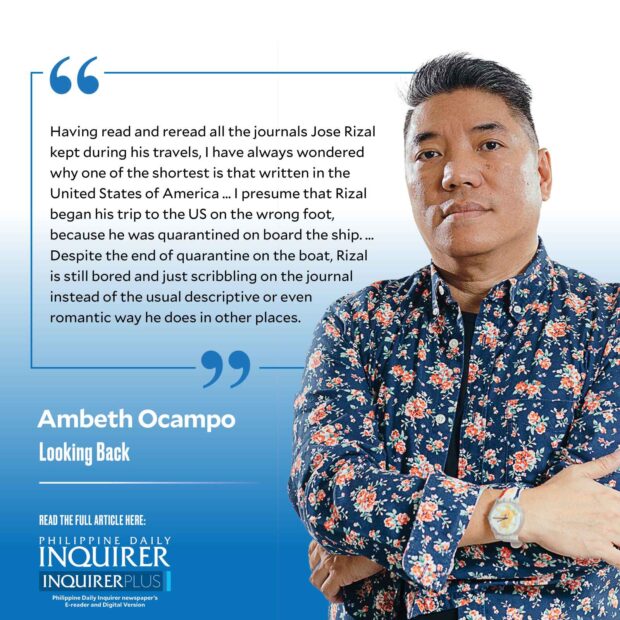Rizal in quarantine
Having read and reread all the journals Jose Rizal kept during his travels, I have always wondered why one of the shortest is that written in the United States of America. He was in the US less than two months, arriving in San Francisco from Japan on Sunday, April 28, 1888, and sailing from New York to Liverpool on Wednesday, May 16, 1888, but that is not an excuse for the dry writing on this trip. Was he preoccupied with something else? Maybe the US was not to his liking? There are travel letters from certain cities that are longer than his US diary.
I presume that Rizal began his trip to the US on the wrong foot, because he was quarantined on board the ship. He began: “We arrived in the morning at San Francisco. We docked. They say that we will be quarantined. The little customs launch came to visit us. They have unloaded the silk cargo, each bail costs $700. They are not afraid of the silk and [went to?] lunch.
Article continues after this advertisement“Sunday, 29 April. The second day of the quarantine. We are bored. I no longer know how to amuse myself.
“Monday 30. The quarantine continues. I read in the newspapers a statement of the health inspector against the quarantine.
“Tuesday, 1 May. The quarantine continues. We sign a protest against the quarantine and the Englishmen write to their consul.
Article continues after this advertisement“Thursday 3 May. Six days of quarantine!”
If he were traveling by air as we do today, such a delay would mean missing his connection to England. Fortunately, he had a lot of time for the long layover.
“On Friday 4 May, at three o’clock in the afternoon, the quarantine ended. I lodged in the Palace Hotel. $4 a day with bath and everything included. Stockton St 312. I saw the Golden Gate … (illegible). The Customs House. A letter of recommendation. On Sunday the stores are closed. The best street in San Francisco is Market Street. Stroll. Stanford, the rich man. A street near Chinatown.
“We left San Francisco on Sunday 6 May, at 4:30 in the afternoon. Steamer till Oakland. Train. Boat from Port Costa to Benicia. Fields. Cattle. There are no huts and shepherds. Tent. Supper in Sacramento, 75 cents. We slept in the train. The night is middling. We awoke one hour from Reno, where we took breakfast at 7:30.
“Monday 7 May. In (illegible) I saw an Indian garbed, half-European, half-Indian, leaning against a wall. Broad desert land with rickety plants without trees or bushes. Uninhabited. Lonely place. Bare mountains. Sandy place. A large extent of white earth that seems like chalk. Beyond this desert can be seen some blue mountains. Fine weather. It is hot and there is still snow on top of some mountains.”
Despite the end of quarantine on the boat, Rizal is still bored and just scribbling on the journal instead of the usual descriptive or even romantic way he does in other places. I have often considered following Rizal’s footsteps by taking a land trip from San Francisco to New York, a trip that friends say can be quite comfortable on a modern Amtrak sleeper train. With the right frame of mind, the barren landscape Rizal describes above might actually be beautiful. Rizal passed through Ogden, commenting, “I believe that with irrigation and a good system of canals these fields can be rendered fertile.” He passed Utah, then on to Denver where he was told to adjust his watch and move it up by an hour. His disposition changes somewhat when he sees yellow flowers and Salt Lake that broke the monotony of barren landscapes. Here, he compares mountains to that on Talim Island, Laguna and notes that here, “asses are very large.” He met three Mormons in Farmingdon, was greeted by children in Salt Lake City. “In Utah,” he observed, “those who wait at tables are women. It shows there are many.”
In Colorado, he described mules, pine trees, and snow “of a resplendent whiteness that is dazzling.” In another place, he marveled at “ice drops” or icicles that “gives off brilliant reflections in sunlight looking real cascades of diamonds with a magical effect.” There were more trees here than the other states they passed and the porter of the train, he complained, “was somewhat of a thief.”
Omaha was a big city like San Francisco, the Missouri River “about twice the Pasig in its widest part. It is marshy … its banks are not pretty.” On May 11, he wrote, “What I observed in Chicago was that every tobacco shop had a statue of an Indian [outside] and always different.” They stopped to see Niagara Falls “truly the most magnificent falls I have seen. It is not as pretty nor as mysteriously beautiful as that in Los Baños, but it is more gigantic and imposing that no comparison is possible. The cataract has several parts, several falls, several portions that any country would be happy to have.” Reaching New York, he compared the Hudson River with the Pasig River.
Rizal always compared foreign landscapes with those back home, proudly remaining Filipino more so when abroad.
—————-
Comments are welcome at aocampo@ateneo.edu

















